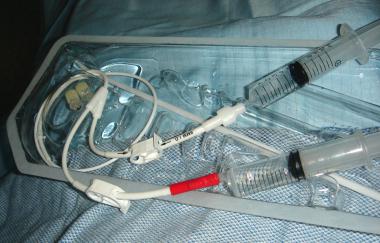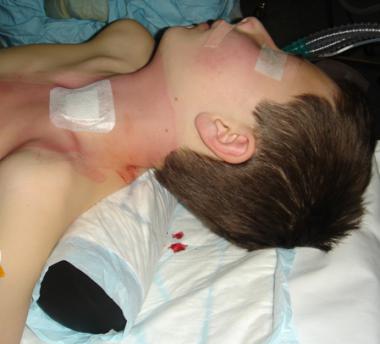Overview
Background
Central venous access is essential in providing quality medical care to many patients for whom intensive therapy is required. In many situations, a semipermanent tunneled central line is preferred (see Indications). An anterior approach to the internal jugular vein (IJV) is the best option in this situation because it offers the easiest route with a low risk of complications.
Background
Central venous access is essential in providing quality medical care to many patients for whom intensive therapy is required. In many situations, a semipermanent tunneled central line is preferred (see Indications). An anterior approach to the internal jugular vein (IJV) is the best option in this situation because it offers the easiest route with a low risk of complications.
In this procedure, a tunneled catheter is surgically inserted into a vein in the neck or chest and passed under the skin. Only the end of the catheter is brought through the skin; medicines and intravenous (IV) fluid can be administered through this catheter; other tasks, such as blood sampling, can also be performed. The fact that the catheter is passed under the skin helps secure the catheter, reduces the rate of infection, and permits free movement of the catheter port. The placement of a tunneled catheter should be carried out by practitioners with specific experience in the procedure.
Compared to femoral site access, internal jugular or subclavian access has been associated with a lower risk of catheter-related bloodstream infections (CRBSIs) in some studies, but subsequent studies have indicated that there is no difference in the rate of CRBSI between these three sites. [1] Overall, the IJV is better suited, especially in children, although other factors such as interindividual vein size variation need to be kept in mind.
Indications
Indications for a tunneled approach to the IJV include the following:
-
Complex or critically ill patients who need continuous hemodynamic monitoring
-
Patients who require secure venous access for the infusion of agents that are very irritating or that have a very narrow therapeutic index, and which, therefore, require a very precise rate of delivery into the circulation (eg, cytotoxic drugs, inotropic agents)
-
Patients who require long-term venous access for parenteral nutrition, chemotherapy, or long-term prophylactic antibiotics
-
Patients in whom very frequent blood sampling or access to the circulation for other reasons is needed
-
Patients in whom venous access cannot be secured by any other route
Contraindications
This procedure has no absolute contraindications. Relative contraindications include the following:
-
Severe coagulopathy
-
Physical status unfit for anesthesia
-
Unavailability of a suitable access site
-
Thrombosed veins
-
Overlying skin infection
In patients who need long-term venous access (eg, patients with small bowel transplant), imaging of the neck veins may be necessary before the procedure.
Doppler ultrasonography (US), magnetic resonance (MR) venography, or both can be used to establish venous patency and anatomy, thus improving planning and anticipation of potential problems with access. [3]
Particularly in patients with multiple medical problems, a complete blood count, clotting profile, and relevant renal and liver function tests should be included in the preoperative workup. Depending on the platelet count, platelet transfusion may be needed.
Periprocedural Care
Equipment
Materials required for the procedure include the following:
-
Central venous catheter tray (line kit; see the images below)
-
Sterile gloves
-
Antiseptic solution with skin swab
-
Sterile drapes or towels
-
Sterile gown
-
Sterile saline flush, approximately 30 mL
-
Lidocaine 1%
-
Gauze
-
Dressing
-
Scalpel, No. 11
-
Vascular forceps (DeBakey)
-
Needle driver
-
Polypropylene suture 4/0
-
Steri-Strips
-
Mepore adhesive tape



Patient preparation
Anesthesia
A local anesthetic agent is used before tunneling the catheter. For more information, see Local Anesthetic Agents, Infiltrative Administration.
Positioning
Trendelenburg position with the head turned to the opposite side of the central venous line (CVL) insertion is optimal, as the internal jugular vein (IJV) distends in this position, providing a maximal cross-sectional area for access, as shown in the image below. The ipsilateral arm should be extended minimally at the axilla. In adults, neutral position of the neck has been shown to be equally safe
Source emedicine.com
Duc Tin Surgical Clinic
Tin tức liên quan

Performance diagnostique de l’interféron gamma dans l’identification de l’origine tuberculeuse des pleurésies exsudatives

A Mixed Phenotype of Airway Wall Thickening and Emphysema Is Associated with Dyspnea and Hospitalization for Chronic Obstructive Pulmonary Disease.

Radiological Approach to Asthma and COPD-The Role of Computed Tomography.

Significant annual cost savings found with UrgoStart in UK and Germany

Thrombolex announces 510(k) clearance of Bashir catheter systems for thromboembolic disorders
Phone: (028) 3981 2678
Mobile: 0903 839 878 - 0909 384 389







